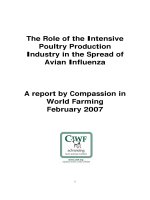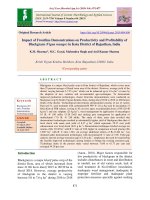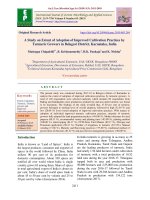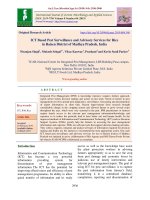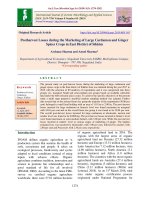Price spread of paddy in Chandrapur district of Maharashtra, India
Bạn đang xem bản rút gọn của tài liệu. Xem và tải ngay bản đầy đủ của tài liệu tại đây (186.02 KB, 7 trang )
Int.J.Curr.Microbiol.App.Sci (2019) 8(5): 1850-1856
International Journal of Current Microbiology and Applied Sciences
ISSN: 2319-7706 Volume 8 Number 05 (2019)
Journal homepage:
Original Research Article
/>
Price Spread of Paddy in Chandrapur District of Maharashtra, India
R.D. Shelke*, S.R. Dhurve and D.U. Meshram
Department of Agricultural Economics, College of Agriculture, Latur, India
*Corresponding author
ABSTRACT
Keywords
Paddy, Marketing
channel, Marketing
cost, Price spread
Article Info
Accepted:
15 April 2019
Available Online:
10 May 2019
Rice belong to genus Oryza. The cultivated species are Oryza sativa and Oryza
glaberrima. Oryza glaberrima has been cultivated in West Africa. Rice is grown under
many different conditions and production system, but submerged in water is the most
common method use worldwide. Rice is the only cereal crop that can grown for long
periods of time in standing water. 57% of rice is grown on irrigated land, 25% on rainfed
lowland, 10% on the uplands, 6% in deepwater and 2% in tidal wetland. The study was
conducted to understand the nature of the marketing channels, marketing costs, margins,
price spread and producer’s share in the consumer’s price of paddy in Chandrapur district
of Maharashtra. The data base consists of producer, wholesalers, and retailers of paddy
from whom primary data were collected by personal interviews with the help of pretested
schedule during 2017-18. Three marketing channels were identified in case of paddy i.e. I.
Producer-Consumer. II .Producer-Retailer-Consumer, III. Producer-Wholesaler-RetailerConsumer. Per farm total production of paddy was 41.34 qtl/ha. Out of the total production
1.65 per cent was retained for family consumption and left was marketed through different
channels. Among marketing cost incurred by different intermediaries marketing cost of
wholesaler was highest and cost incurred by producer was lowest. Channel I was most
efficient with 58.38 price spread and 97.52 per cent producer’s share in consumer rupee.
And price spread was highest in the channel III where number of intermediaries was also
more.
Introduction
Rice cultivation started in the 15th century in
South East Asia and spread to India, China
and Japan. Rice was first domesticated in the
region of the Yangtze River valley in China,
however rice was found in its wild form in
India. Rice goes through a series of
processing before finally reaching the dinner
table. Rice cultivation involves seed selection
followed by land preparation that is aimed to
place the soil in the best physical condition
for crop growth and to ensure that soil surface
is level. Seeds are sown in seed bed. Further,
crop establishment involves transplanting,
where
pre-germinated
seedlings
are
transferred from seed bed to wet field.
Transplantation is done manually by hand
after a period of 20-40 days. Water
management is a crucial step where the field
is maintained in a flooded condition to
conserve water sufficient for the crop.
1850
Int.J.Curr.Microbiol.App.Sci (2019) 8(5): 1850-1856
Rice commends recognition, as a supreme
commodity to mankind, because rice is truly
life, culture, a tradition and a means of
livelihood to millions. It is an important staple
food providing 66-70 per cent body calorie
intake to the consumers. Nutrient value of
rice, it content highest amount of
carbohydrate about 65-70%,7-8% protein,23% fat and a rich source of mineral and
vitamins like phosphorus, manganese, iron,
folic acid, thiamine and niacin. The United
Nations General Assembly, in a resolution
declared the year of 2004 as the “International
Year of Rice”, which has tremendous
significance to food security.
retailers. A sample of 90 respondents
including 60 farmers, 20 wholesalers, 10
retailers and were randomly selected and
interviewed based on pretested schedule in
Warora taluka of Chandrapur district.
In 2016-2017 area and production of paddy in
World 160.12 (MH), 486.39 (MT) and
productivity is 4.53 (T/ha). In 2016-2017 area
and production of paddy in India is 42.95
(MH), 110.15 (MT) and productivity is
3.85(T/ha). The total area, production and
productivity of paddy in Maharashtra during
the year 2016-2017 is 14.66(MH), 34.19(MT)
and 2333 (Kg/ha).
Major marketing channel in the study area
The major rice importing countries of India
are Nigeria, Philippines, Saudi Arabia, Iraq,
Iran, Malaysia, Brazil, Persian Gulf countries,
Europe, South Africa, Bangladesh and
Indonesia.
In 2017-2018 area and production of paddy in
Maharashtra 1446.6(MH), 2660.5MT) and
productivity is 1839(T/ha).In 2017-2018 area
and production of paddy in World 165 (MH),
495.9 (MT), and productivity is 210 (T/Ha).
In 2017-2018 area, production and
productivity of paddy in India 42949.80(Ha),
112905.50 (MT) and 2585(Kg/ha).(SourceIndia. agri. stat. and FAO)
Materials and Methods
Market channels for paddy were identified by
primary data from farmers, wholesalers, and
Primary data regarding purchase price,
marketing cost incurred, sale price and other
related information were collected from the
respondents.
The data, thus collected was subjected to
tabular analysis obtaining percentages.
Results and Discussion
Marketing channels reveal that how produce
passes through different agencies from
producer to final consumer.
In the study area following prominent
channels were observed in the marketing,
Producer – Consumer
Producer – Retailer – Consumer
Producer – Wholesaler – Retailer –
Consumer.
Production, retention and
surplus of paddy marketing
marketed
Production, retention and marketed surplus of
paddy sold through different channels were
calculated and are presented in table 1.
Production of paddy was 41.34 quintals on
1.10 hectares and its retention paddy for
consumption seed was 1.65 quintals.
The results revealed that quantity of paddy as
10.88, 12.74 and 16.07 quintals were
marketed through channel-I, channel-II, and
channel-III. Thus total marketed surplus of
paddy was 39.69 i.e. 100 per cent
1851
Int.J.Curr.Microbiol.App.Sci (2019) 8(5): 1850-1856
Marketing cost of paddy incurred by
different intermediaries
Marketing cost of paddy incurred by
producer
Item wise per quintal cost of marketing of
paddy incurred by producer in different
channels was calculated and presented in
table 2. The cost incurred by the producer was
Rs.53.38 per quintal in channel-I, 79.07 in
channel-II and 85.83 per quintal in channelIII. It was observed that, the proportionate
expenditure in the total cost was highest
packaging charges (80.81 per cent) followed
by unloading charges (6.66 per cent), loading
charges (6.51 per cent), transportation charges
(5.97 per cent). In channel-II maximum share
was on packaging charges (56.34 per cent)
followed by commission charges (21.41 per
cent),transportation charges (14.02 per
cent),loading charges (3.85 per cent) and
unloading charges (2.71 per cent) and
weighing charges (1.64 per cent), In channelIII
maximum share was on packaging
charges (55.38 per cent) followed by
commission charges (19.98 per cent),
transportation charges (17.75 per cent),
unloading charges (2.67 per cent), loading
charges (2.56 per cent), unloading charges
(2.67 per cent) and weighing charges (1.63)
per cent.
Marketing cost of paddy incurred by
wholesaler
Per quintal marketing cost of paddy incurred
by wholesaler with respect to various items in
different marketing channels were calculated
and presented in table 3. In regard to
marketing cost incurred by wholesaler in
channel-III, it was Rs.91.62 per quintals.
Proportionate expenditure on packaging
charge was the highest as (53.42) per cent,
followed by commission charge (19.20) per
cent, transportation charge (16.21) per cent,
losses (3.27) per cent, loading charge (2.77)
per cent, unloading (2.52) per cent, weighing
charge (1.52) per cent, license charge (0.65)
per cent and market fee (0.39) per cent in
channel-III
Marketing cost of paddy incurred by
village retailer
Per quintal cost of marketing of paddy
incurred by retailer channel-II and channel-III
was calculated and presented in table 4. The
result revealed that highest incurred by
wholesaler cost was Rs 27.37 in channel-III
followed by Rs 25.70 channel-II. In which
share of transportation charges was high as
71.39 per cent in channel-III followed by
channel-II i.e. 70.23 per cent, losses of paddy
was high i.e. 16.30 per cent in channel-II
followed by channel-III 13.84 per cent,
storage charges was high as 7.50 per cent in
channel-II as compared to channel- III7.01
per cent, market fee was high as 2.74 in
channel- III followed by channel-II 2.14 per
cent, license charges 2.63 per cent in channelIII followed by channel-II 2.60 per cent, shop
tax charges 2.37 per cent channel-III followed
by channel-II 1.20 per cent.
Price spread in paddy marketing
Per quintal marketing cost, marketing margin
and price spread in marketing of paddy with
respect to different channels were calculated
and presented in table 5. The result revealed
that, in regard to channel-I net price received
by producer from consumer was Rs 2300.35
while cost incurred by producer was Rs 58.38.
The price paid by consumer was Rs 2358.73
thus price spread was found to be Rs 58.38. In
channel-I producers share in consumer's rupee
was found to be 97.52 per cent.
In regard to channel-II price received by
producer from retailer was Rs. 2250.25 while
cost incurred by producer was Rs 79.09. The
1852
Int.J.Curr.Microbiol.App.Sci (2019) 8(5): 1850-1856
cost incurred by retailer and margin of retailer
was Rs 25.70 and Rs 183.88, respectively.
The price paid by consumer was Rs 2538.92.
Thus, price spread was found to be Rs 288.67.
In channel-II producer's share in consumer's
rupee was found to be 88.63 per cent. It was
clear that, producer's share in consumer's
rupee was maximum in channel-I. It was
observed that, marketing cost in channel-I
was 58.38. Thus price spread was found to be
Rs 58.38. In channel-II marketing cost was
104.79 and margin was Rs 183.88. Thus price
spread was found to be Rs 288.67.
Table.1 Per farm Production, retention and marketed surplus of paddy (qtl/farm)
Sr. No.
1
2
3
4
5
6
7
Particulars
Paddy farm size (ha)
production of paddy (q)
Retention paddy for consumption(q)
Marketed surplus in channel-I(q)
(Producer-Consumer)
Marketed surplus in channel-II(q)
(Producer-Retailer-Consumer)
Marketed surplus in channel-III(q)
(Producer-Wholesaler-Retailer-Consumer)
Total marketed surplus(q)
Paddy farm
1.10
41.34
1.65
10.88
(27.24)
12.74
(32.09)
16.07
(40.48)
39.69
(100)
(Figure in parenthesis is the percentage to the marketed surplus in different channel
Table 2 Marketing cost incurred by paddy producer in different channel (Rs/q)
Sr. No
Particulars
1.
Packaging charge
2.
Loading charges
3.
Transport charges
4.
unloading charges
5.
Weighing charges
6.
Commission charges
TOTAL
Channel-I
(ProducerConsumer)
43.14
(80.81)
3.48
(6.51)
3.2
(5.97)
3.56
(6.66)
53.38
(100)
(Figure in parenthesis is the percentage to the cost incurred by producer)
1853
Channel-II
(ProducerRetailerConsumer)
44.55
(56.34)
3.05
(3.85)
11.09
(14.02)
2.15
(2.71)
1.30
(1.64)
16.93
(21.41)
79.07
(100)
Channel-III
(ProducerWholesaler-RetailerConsumer
47.54
(55.38)
2.20
(2.56)
15.24
(17.75)
2.30
(2.67)
1.40
(1.63)
17.15
(19.98)
85.83
(100)
Int.J.Curr.Microbiol.App.Sci (2019) 8(5): 1850-1856
Table 3 Marketing cost incurred by wholesaler in channel-III (Rs/q)
Sr. No
1.
Particulars
Packaging charge
2.
Loading charges
3.
Transport charges
4.
unloading charges
5.
License charges
6.
Weighing charges
7.
Commission charges
8.
Market fee
9.
Losses
Channel-III
48.95
(53.42)
2.54
(2.77)
14.86
(16.21)
2.31
(2.52)
0.60
(0.65)
1.40
(1.52)
17.60
(19.20)
0.36
(0.39)
3.00
(3.27)
91.62
(100)
TOTAL
(Figure in parenthesis is the percentage to the cost incurred by wholesaler)
Table.4.Marketing cost incurred by retailer (Rs/q)
Sr. No
1.
Particulars
Transport charges
2.
Licence charge
3.
Shop tax
4.
Storage charges
5.
Market fees
6.
Losses
1
TOTAL COST
Channel-II
18.05
(70.23)
0.67
(2.60)
0.31
(1.20)
1.93
(7.50)
0.55
(2.14)
4.19
(16.30)
25.70
(100)
(Figure in parenthesis is the percentage to the cost incurred by retailer)
1854
Channel-III
19.54
(71.39)
0.72
(2.63)
0.65
(2.37)
1.92
(7.01)
0.75
(2.74)
3.79
(13.84)
27.37
(100)
Int.J.Curr.Microbiol.App.Sci (2019) 8(5): 1850-1856
Table.5 Per quintal marketing cost, margin and price spread in paddy (Rs/q)
Sr. No Particulars
1
Net price received by
producer(producer share in
consumer rupee)
Cost incurred by producer
2
Channel-I
2300.35
(97.52)
Channel-II
2250.25
(88.63)
Channel-III
2170.22
(76.25)
79.09
(3.11)
-
85.83
(3.01)
2256.05
(79.27)
91.62
(3.21)
90.07
(3.16)
2437.74
(85.66)
27.37
(0.96)
380.72
(13.38)
2845.83
(100)
113.2
(3.97)
380.72
(13.38)
493.92
(17.35)
3
Price paid by wholesaler
58.38
(2.47)
-
4
Cost incurred by wholesaler
-
-
5
Margin of wholesaler
-
-
6
Price paid by retailer
-
7
Cost incurred by retailer
-
8
Margin of retailer
-
9
Price paid by consumer
10
Marketing cost
11
Marketing margin
2358.73
(100)
58.38
(2.47)
-
12
Price spread
2329.34
(91.74)
25.70
(1.01)
183.88
(7.24)
2538.92
(100)
104.79
(4.12)
183.88
(7.24)
288.67
(11.36)
58.38
(2.47)
(Figure in parenthesis is the percentage to the marketing cost, margin and price spread)
In channel-III, that the price paid by
consumer
in
this
channel
was
Rs 2845.83. It was clear that, the price receive
d by the producer from wholesaler was Rs
2170.22 while cost incurred by producer was
Rs 85.83. In next order, cost incurred by the
wholesaler was Rs 91.62 while marketing
margin of wholesaler was Rs 90.07. The
wholesaler had sold the produce to retailer at
Rs 2437.74. Next order, cost incurred by
retailer was Rs 27.37 while marketing margin
was 380.72 and thus it inferred that, in this
channel the marketing cost was Rs 113.2
while marketing margin was Rs 380.72 and
the price spread was found to be Rs 493.92. It
inferred that, price spread was found higher in
channel-III as compared to channel-I and
channel-II.
In conclusion, three marketing channels were
identified in case of paddy (i.e. I. ProducerConsumer. II. Producer-Retailer-Consumer,
and
III
Producer-Wholesaler-RetailerConsumer). Among marketing cost incurred
by different intermediaries marketing cost of
wholesaler was highest and cost incurred by
producer was lowest. Channel I was most
efficient with 58.38 price spread and 97.52
per cent producer’s share in consumer rupee
because the produce was directly marketed
1855
Int.J.Curr.Microbiol.App.Sci (2019) 8(5): 1850-1856
from producer to consumer and price spread
was highest in the channel III where number
of intermediaries was also more.
References
Anandaraj, P., (2014). Cost, Returns and
Marketing Channels of Paddy in
Thiruvarur
District
(Tamilnadu).
International journal of science and
research, 4(11): 2319-7064.
Bidyasagar Talukdar and SRF Nicer, (2017).
Marketing Channels and Marketing
analysis for rice Nalbari district of
Assam (India). International journal
of Chemical studies, 5(5):1285-1289.
Kumar V., Kumar Vinod, Kumar A.,
Kochewad S. and Singh Mahendra,
(2017).
Marketing
Channels,
Marketing
Cost
Margin
and
Producer’s share in Consumer’s rupee
in Paddy Marketing. Agro. Economistand International Journals, 4(1): 2127.
Ramesh C., (2016). Marketing Efficiency: A
Special Focus on Paddy Cultivators In
Cuddalore District. International
Journal of Economics and Business
Review, 4(8): 2347-9671.
Sarvanakumar, V and Kiruthika N., (2015).
Economic analysis of Production and
Marketing of Paddy in Tamil Nadu.
International Research Journal of
Agricultural Economic and Statistics,
6(2): 2231-6434.
How to cite this article:
Shelke, R.D., S.R. Dhurve and Meshram, D.U. 2019. Price Spread of Paddy in Chandrapur
District of Maharashtra, India. Int.J.Curr.Microbiol.App.Sci. 8(05): 1850-1856.
doi: />
1856
